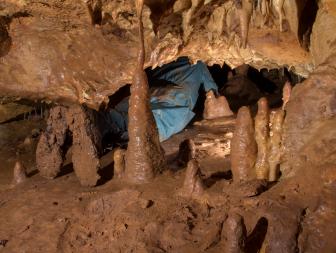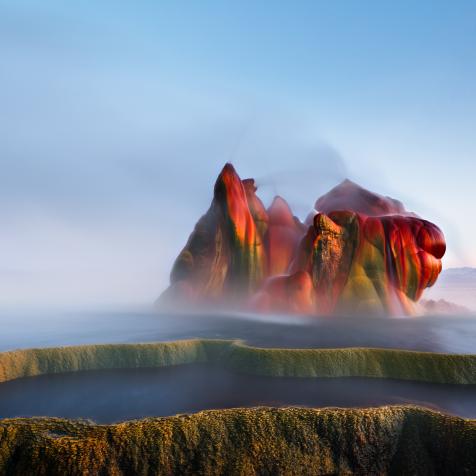
Bennett Lee
Into Uncharted Territory: Texas Caving
From the pages of The Explorers Journal, climb into a famed Texas “show cave” that has far more to reveal with Explorers Club fellow C. William “Bill” Steele.
Had the spring field season gone according to plan, I would have been heading back down to southern Mexico with my fellow cavers to continue our push ever deeper into Sistema Huautla, which, at 1,560 meters, is the deepest cave system in the Western Hemisphere. This year, I was to have been joined by a team of 27 of the world’s top speleologists from five countries. With the coming of the Covid-19 pandemic, however, we were forced to scrap our April-May expedition two weeks prior to departure.
With my international travel feathers temporarily clipped, and not one to sit idly by, I decided to turn my proverbial headlamp back onto speleological treasures closer to home—in this case, a world-class “show cave” known as Natural Bridge Caverns (NBC) on the outskirts of San Antonio, where last summer we discovered some 500 meters of previously unknown passageways. These are the first to be found since the Texas Hill Country cave was designated a National Natural Landmark in 1971, and it is funny to think, they might never have been found had it not been for chance discussion with Orion Knox, a friend of many years who, along with three of his fellow St. Mary’s University students—Preston Knodell, Al Brandt, and Joe Cantu—had discovered NBC back in March of 1960.

Bennett Lee
In October 2018, Orion agreed the lead a tour of NBC for fellow members of the Texas Chapter of The Explorers Club, after which my partner Diana Tomchick asked if there were any remaining passages to be explored. With a slight smile, he pointed to a place on a map of the cave marked the “Dome Pit,” well beyond the extraordinary chambers that are open to the public.
Orion said he suspected that there was a passage near the top of the dome, but when he and his buddies surveyed the cave back in the 1960s, their carbide lamps were not bright enough to see if indeed there was one. He also highlighted the fact that the Dome Pit’s walls were soft in places, making it difficult, if not impossible, to climb. My curiosity piqued, I smiled at Diana. Without saying a word, we knew it probably could be climbed by someone with the right skill set. I knew just who to call—Lee White, who had been a key member of our Sistema Huautla team since 2017. But before I reached out to Lee, Diana and I would scope out the situation firsthand.
In February 2019, we returned to NBC, where we met up with Brad and Travis Wuest, third-generation owners of the caverns, which happened to be located on private property. After a brief discussion, we set off for the Dome Pit along with the brothers and two of their NBC guides and surveyors, Justin Royce and Dillon Ellis. Passing beyond the exit tunnel that marked the end of the paved tourist trail within the cave, we went over a handrail, down a flight of concrete steps, and into a suite of undeveloped passageways and chambers, including a massive one known as the Inferno Room, which is filled with blocks of rock and dangling speleothems. Within minutes we found ourselves squeezing, climbing slippery muddy slopes, stoop-walking, belly crawling, and working our way through constrictions, which necessitated contortionist moves. An hour and a half later, we reached the Dome Pit.
Photos of Uncharted Territory 7 Photos
In partnership with The Explorers Club, Discovery gives you a look inside the cave expedition with leading cave photographer, Bennett Lee.
Its light-colored limestone walls towered more than 30 meters up to a rather flat ceiling. Our bright Scurion headlamps lit up the chamber and it appeared that was indeed a large passage at the top, which could be reached using serious aid climbing. Following our inspection, I got in touch with Lee and he agreed join us for our return to the Dome Pit in early May, once we had concluded our spring Huautla expedition. In the meantime, the Wuest brothers would return to the Dome Pit with a drone operator who flew his craft up to the ceiling and into the passage at the top, which appeared to contain large stalagmites.
Following an early morning planning session on May 8, made our way back to the Dome Pit, where Lee immediately began scanning the walls for a suitable route to the top. Within minutes he started up, setting a suite of bolts in the rock as he made his ascent with me belaying from below. An hour and a half later, Lee reached the top, shouting down to us, “It goes!”
He pulled up the belay rope, rigged a static that would provide access for the team, and rappelled back down, removing the hangers along the way.

Bennett Lee
One by one we jumarred our way up and into the previously unknown passage. Nearly 200 meters in, we came to a large pit in the floor with the passage continuing for another 100 meters beyond it before terminating in “T.” Dropping into the pit in the floor, which about 30 meters deep, we encountered into a nice-sized passage with rimstone dams, pools of crystal-clear water, and large stalagmites. It was clear then that the passage opened up with impressive formations much like the ones for which the show part of the cave is known, which warranted further exploration.
Since our initial foray into the cave in 2019, we have returned to the cave several times with plans to continue our push into the system later this fall and early next year with more than 600 meters of new cave passages having been explored and mapped, both traditionally and with the aid of LIDAR. And our excitement continues to build about NBC’s potential, tempered only by the sudden loss of Lee White. In September 2019, the best cave wall climber in the world was tragically killed in a car crash at age 31. We plan to carry on his unbridled spirit as we continue to explore one of Earth’s great geological wonders.
About C. William "Bill" Steele
Steele has ventured into some of the deepest caves in the world, including Sistema Huautla in the Mexican state of Oaxaca, where he has led more than a dozen Explorers Club flag expeditions over the past four decades. Since 1970, Steele has been involved in the exploration and mapping of Mammoth Cave in Kentucky, the world’s longest cave. Leading cave photographer, Bennett Lee, started caving as a teen with Bill Steele some three decades ago. For more of his work, visit: bennettlee.com.
This story originally appeared in the pages of The Explorers Journal, the official quarterly of The Explorers Club since 1921. From vast ocean depths to the frontiers of outer space, The Explorers Journal offers readers first-hand reporting from those pushing the limits of knowledge and human endurance. For more stories, subscribe today.




















